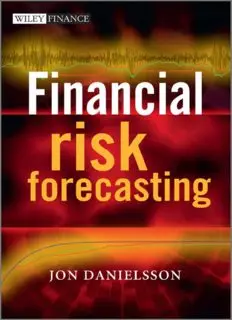Table Of ContentFinancial Risk Forecasting
For other titles in the Wiley Finance Series please see
www.wiley.com/finance
Financial Risk Forecasting
The Theory and Practice of Forecasting Market Risk,
with Implementation in R and Matlab
Jo´ n Danı´elsson
A John Wiley and Sons, Ltd, Publication
Thiseditionfirstpublished2011
Copyright#2011Jo´nDanı´elsson
Registeredoffice
JohnWiley&SonsLtd,TheAtrium,SouthernGate,Chichester,WestSussex,PO198SQ,UnitedKingdom
Fordetailsofourglobaleditorialoffices,forcustomerservicesandforinformationabouthowtoapplyfor
permissiontoreusethecopyrightmaterialinthisbookpleaseseeourwebsiteatwww.wiley.com
Therightoftheauthortobeidentifiedastheauthorofthisworkhasbeenassertedinaccordancewiththe
Copyright,DesignsandPatentsAct1988.
Allrightsreserved.Nopartofthispublicationmaybereproduced,storedinaretrievalsystem,ortransmitted,
in any form or by any means, electronic, mechanical, photocopying, recording or otherwise, except as
permittedbytheUKCopyright,DesignsandPatentsAct1988,withoutthepriorpermissionofthepublisher.
Wileyalsopublishesitsbooksinavarietyofelectronicformats.Somecontentthatappearsinprintmaynotbe
availableinelectronicbooks.
Designations used by companies to distinguish their products are often claimed as trademarks. All brand
namesandproductnamesusedinthisbookaretradenames,servicemarks,trademarksorregisteredtrade-
marksoftheirrespectiveowners.Thepublisherisnotassociatedwithanyproductorvendormentionedinthis
book.Thispublicationisdesignedtoprovideaccurateandauthoritativeinformationinregardtothesubject
mattercovered.Itissoldontheunderstandingthatthepublisherisnotengagedinrenderingprofessional
services.Ifprofessionaladviceorotherexpertassistanceisrequired,theservicesofacompetentprofessional
shouldbesought.
ISBN978-0-470-66943-3(hardback)
ISBN978-1-119-97710-0(ebook)
ISBN978-1-119-97711-7(ebook)
ISBN978-1-119-97712-4(ebook)
AcataloguerecordforthisbookisavailablefromtheBritishLibrary.
ProjectmanagementbyOPSLtd,GtYarmouth,Norfolk
Typesetin10/12ptTimes
PrintedinGreatBritainbyCPIAntonyRowe,Chippenham,Wiltshire
Contents
Contents
Preface xiii
Acknowledgments xv
Abbreviations xvii
Notation xix
1 Financial markets, prices and risk 1
1.1 Prices, returns and stock indices 2
1.1.1 Stock indices 2
1.1.2 Prices and returns 2
1.2 S&P 500 returns 5
1.2.1 S&P 500 statistics 6
1.2.2 S&P 500 statistics in R and Matlab 7
1.3 The stylized facts of financial returns 9
1.4 Volatility 9
1.4.1 Volatility clusters 11
1.4.2 Volatility clusters and the ACF 12
1.5 Nonnormality and fat tails 14
1.6 Identification of fat tails 16
1.6.1 Statistical tests for fat tails 16
1.6.2 Graphical methods for fat tail analysis 17
1.6.3 Implications of fat tails in finance 20
1.7 Nonlinear dependence 21
1.7.1 Sample evidence of nonlinear dependence 22
1.7.2 Exceedance correlations 23
1.8 Copulas 25
1.8.1 The Gaussian copula 25
1.8.2 The theory of copulas 25
1.8.3 An application of copulas 27
1.8.4 Some challenges in using copulas 28
1.9 Summary 29
vi Contents
2 Univariate volatility modeling 31
2.1 Modeling volatility 31
2.2 Simple volatility models 32
2.2.1 Moving average models 32
2.2.2 EWMA model 33
2.3 GARCH and conditional volatility 35
2.3.1 ARCH 36
2.3.2 GARCH 38
2.3.3 The ‘‘memory’’ of a GARCH model 39
2.3.4 Normal GARCH 40
2.3.5 Student-t GARCH 40
2.3.6 (G)ARCH in mean 41
2.4 Maximum likelihood estimation of volatility models 41
2.4.1 The ARCH(1) likelihood function 42
2.4.2 The GARCH(1,1) likelihood function 42
2.4.3 On the importance of (cid:2) 43
1
2.4.4 Issues in estimation 43
2.5 Diagnosing volatility models 44
2.5.1 Likelihood ratio tests and parameter significance 44
2.5.2 Analysis of model residuals 45
2.5.3 Statistical goodness-of-fit measures 45
2.6 Application of ARCH and GARCH 46
2.6.1 Estimation results 46
2.6.2 Likelihood ratio tests 47
2.6.3 Residual analysis 47
2.6.4 Graphical analysis 48
2.6.5 Implementation 48
2.7 Other GARCH-type models 51
2.7.1 Leverage effects and asymmetry 51
2.7.2 Power models 52
2.7.3 APARCH 52
2.7.4 Application of APARCH models 52
2.7.5 Estimation of APARCH 53
2.8 Alternative volatility models 54
2.8.1 Implied volatility 54
2.8.2 Realized volatility 55
2.8.3 Stochastic volatility 55
2.9 Summary 56
3 Multivariate volatility models 57
3.1 Multivariate volatility forecasting 57
3.1.1 Application 58
3.2 EWMA 59
3.3 Orthogonal GARCH 62
3.3.1 Orthogonalizing covariance 62
3.3.2 Implementation 62
3.3.3 Large-scale implementations 63
Contents vii
3.4 CCC and DCC models 63
3.4.1 Constant conditional correlations (CCC) 64
3.4.2 Dynamic conditional correlations (DCC) 64
3.4.3 Implementation 65
3.5 Estimation comparison 65
3.6 Multivariate extensions of GARCH 67
3.6.1 Numerical problems 69
3.6.2 The BEKK model 69
3.7 Summary 70
4 Risk measures 73
4.1 Defining and measuring risk 73
4.2 Volatility 75
4.3 Value-at-risk 76
4.3.1 Is VaR a negative or positive number? 77
4.3.2 The three steps in VaR calculations 78
4.3.3 Interpreting and analyzing VaR 78
4.3.4 VaR and normality 79
4.3.5 Sign of VaR 79
4.4 Issues in applying VaR 80
4.4.1 VaR is only a quantile 80
4.4.2 Coherence 81
4.4.3 Does VaR really violate subadditivity? 83
4.4.4 Manipulating VaR 84
4.5 Expected shortfall 85
4.6 Holding periods, scaling and the square root of time 89
4.6.1 Length of holding periods 89
4.6.2 Square-root-of-time scaling 90
4.7 Summary 90
5 Implementing risk forecasts 93
5.1 Application 93
5.2 Historical simulation 95
5.2.1 Expected shortfall estimation 97
5.2.2 Importance of window size 97
5.3 Risk measures and parametric methods 98
5.3.1 Deriving VaR 99
5.3.2 VaR when returns are normally distributed 101
5.3.3 VaR under the Student-t distribution 102
5.3.4 Expected shortfall under normality 103
5.4 What about expected returns? 104
5.5 VaR with time-dependent volatility 106
5.5.1 Moving average 106
5.5.2 EWMA 107
5.5.3 GARCH normal 108
5.5.4 Other GARCH models 109
5.6 Summary 109
viii Contents
6 Analytical value-at-risk for options and bonds 111
6.1 Bonds 112
6.1.1 Duration-normal VaR 112
6.1.2 Accuracy of duration-normal VaR 114
6.1.3 Convexity and VaR 114
6.2 Options 115
6.2.1 Implementation 117
6.2.2 Delta-normal VaR 119
6.2.3 Delta and gamma 120
6.3 Summary 120
7 Simulation methods for VaR for options and bonds 121
7.1 Pseudo random number generators 122
7.1.1 Linear congruental generators 122
7.1.2 Nonuniform RNGs and transformation methods 123
7.2 Simulation pricing 124
7.2.1 Bonds 125
7.2.2 Options 129
7.3 Simulation of VaR for one asset 132
7.3.1 Monte Carlo VaR with one basic asset 133
7.3.2 VaR of an option on a basic asset 134
7.3.3 Options and a stock 136
7.4 Simulation of portfolio VaR 137
7.4.1 Simulation of portfolio VaR for basic assets 137
7.4.2 Portfolio VaR for options 139
7.4.3 Richer versions 139
7.5 Issues in simulation estimation 140
7.5.1 The quality of the RNG 140
7.5.2 Number of simulations 140
7.6 Summary 142
8 Backtesting and stress testing 143
8.1 Backtesting 143
8.1.1 Market risk regulations 146
8.1.2 Estimation window length 146
8.1.3 Testing window length 147
8.1.4 Violation ratios 147
8.2 Backtesting the S&P 500 147
8.2.1 Analysis 150
8.3 Significance of backtests 153
8.3.1 Bernoulli coverage test 154
8.3.2 Testing the independence of violations 155
8.3.3 Testing VaR for the S&P 500 157
8.3.4 Joint test 159
8.3.5 Loss-function-based backtests 159
8.4 Expected shortfall backtesting 160
8.5 Problems with backtesting 162

